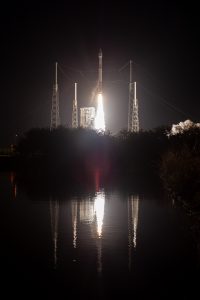SESDA Communications Staff Support Solar Orbiter Launch, a Mission Taking Solar Science to New Heights
February 27, 2020

More than ten SESDA science writers, outreach and production staff travelled to Kennedy Space Center to help NASA communicate launch events to the public. Solar Orbiter, a new collaborative mission between ESA (European Space Agency) and NASA to study the Sun, launched at 11:03 p.m. EST on Feb. 9, 2020, on a United Launch Alliance Atlas V rocket from Launch Complex 41 at Cape Canaveral Air Force Station in Florida. With a scientific payload of 10 different instruments — each complementing and supporting the others — Solar Orbiter combines high-resolution telescopes with measurements from the environment directly surrounding the spacecraft. Together the observations create a one-of-a-kind, comprehensive picture of the Sun’s inner workings and how they can affect the space environment further out in the solar system. During its mission, Solar Orbiter will journey out of the ecliptic plane — the belt of space roughly aligned with the Sun’s equator through which the planets orbit — to get a bird’s eye view of the Sun’s poles. This unprecedented perspective will allow Solar Orbiter to take the first-ever images of this region on the Sun.
Comments are closed.
-
Article Details:
Posted on: Thursday, February 27th, 2020
Posted in: News, SESDA News
Subscribe: RSS 2.0
Comments: No Responses -
Recent News:
